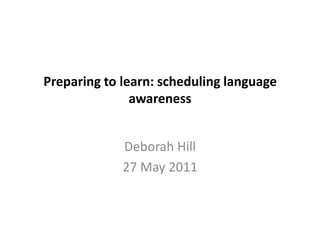
Preparing to Learn
- 1. Preparing to learn: scheduling language awareness Deborah Hill 27 May 2011
- 2. Background Awareness that lack of language awareness was a problem for some students taking English Grammar. Wanted students to develop a better understanding of the relationship between the language we use and the terms we can use to talk about it (i.e. Have a more integrated understanding of grammar) Using time before class to raise language awareness (‘pre-workshop activities’). This meant, starting with what students know (language, but not necessarily the terms to talk about it.)
- 4. What is the model capturing? The model captures the general learning process: e.g. (a) prepare; (b) know; (c) apply; (d) understand (or concepts relevant to another unit) The model identifies what the skills or outcomes related to the general concepts are for a particular unit (in EG, to be prepared meant ‘to notice and observe’ language). The model represents my understanding of grammar and grammar learning and conveys that visually to students.
- 5. How is the model implemented in terms of time? Timetable, timetable, timetable The most difficult thing was to work out where to fit everything in: Over a week Over a semester Weekly: pre-workshop activities (most weeks) Lecture or lecture notes (5 X 1.5 hours lecture) Workshop (10 X 2 hours)
- 7. How does the model reflect learning outcomes? The concepts in the model need to be linked to assessment. Example of an assignment linking the concepts from the model with the learning outcomes of Learning outcomes They will be able to recognise and explain a range of basic grammatical forms and sentence structures. They will also be able to apply this knowledge in their academic study and communication (e.g. writing). Assessment item Analyse a text in terms of its key grammatical characteristics. Where possible, choose a text that is significant or relevant to you in your personal or professional life (...) Assessment criteria: 1. Introduce the text – (topic, reason for choosing it, genre, length, source) 2. Describe and explain the key grammatical characteristics of the text, providing examples from the text to illustrate each of the characteristics. 3. Describe and explain three additional grammatical points relevant to the text (e.g. a clause type that occurs just once in the text) 4. Discuss the relationship between language use and grammar based on this text. [i.e. Synthesise]
- 9. What does a pre-workshop activity look like? Find two texts of different types (e.g. a children’s story and a news report) that contain adjectives, adverbs and prepositions. (You may not find all three in one text.) You should aim for texts that contain at least 3 of each. What kind of text is it? (Hint: If you are looking for adjectives then look for texts that focus on describing something. For example, travel brochures often contain adjectives describing the destination.) Prepositional phrases are often used to refer to ‘space and time’ (e.g. in the garden; in the morning). Do any of the examples you have found express space or time or is the connection looser – (e.g. in a hurry)? Note that a prepositional phrase consists of a Preposition + Noun Phrase
- 10. Transferability of the model First, choose your unit: Is there a unit you teach where you feel students need to develop skills or knowledge before they come to class so that they can get the most out of class time? Is there a unit where some content could be delivered outside scheduled class time (i.e. Watch something on the internet; take a quiz; read something general on a topic you are covering) Next step for the model: The model will be used in S2 and I will be working with a colleague from UPNG to use the model for a sociolinguistic unit where students meet intermittently, and have a varied backgrounds.
- 11. Benefits More time for research Students who did the pre-workshop activities were better prepared for the tutorials The pre-workshop activities could be tailored for UG and G students. Students ‘perceived’ the explanations of grammar in the tutorials as ‘clear and simple’ Pre-workshop activities formed the basis of other assessment (double dipping) The delivery and content of the unit better reflected my own view of ‘grammar’ and its relationship to ‘language’
- 12. Disadvantages If students chose not to engage early, they didn’t engage at all. Perhaps have a higher failure rate than usual (but better learning outcomes for those who did engage)
